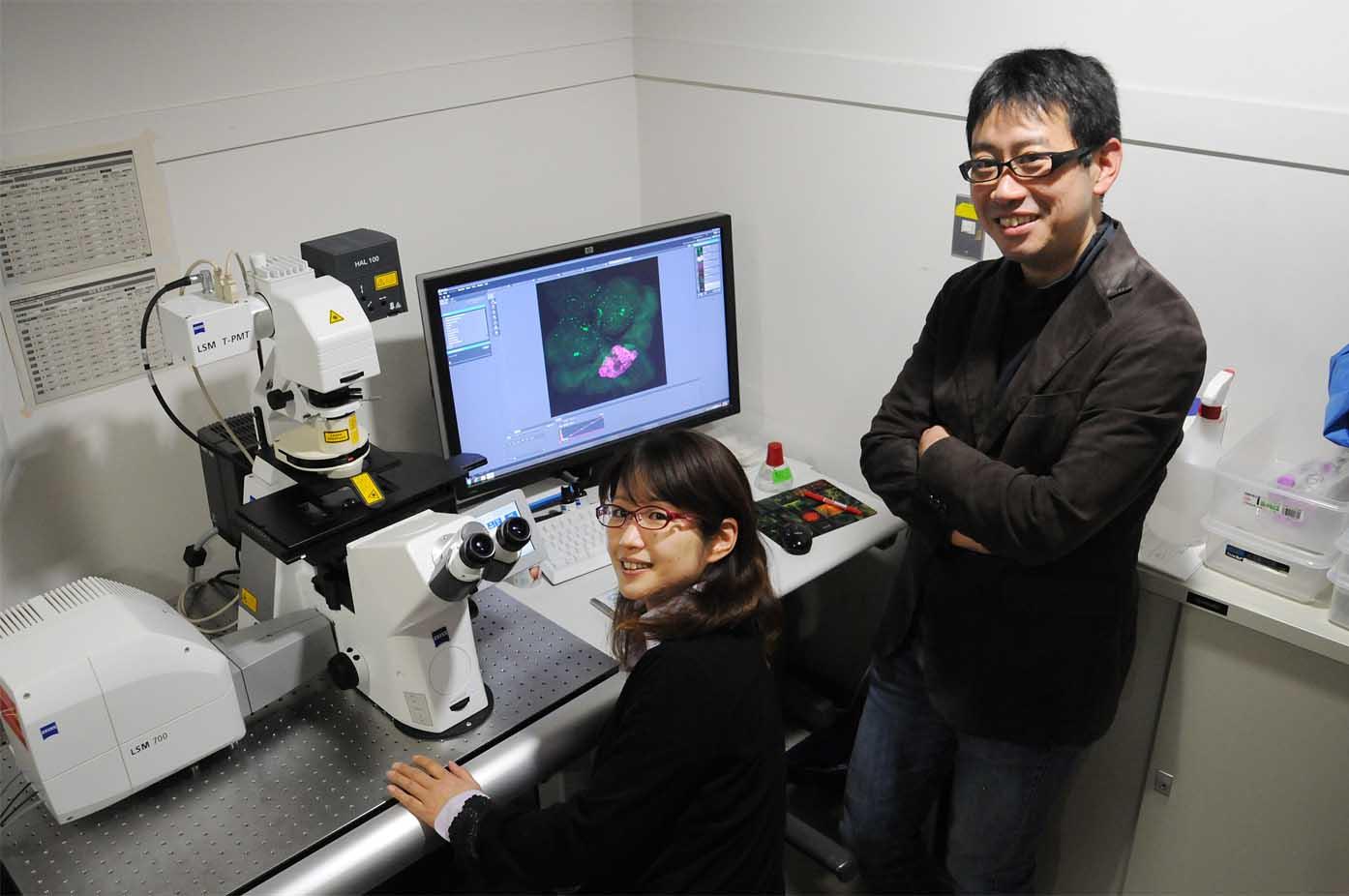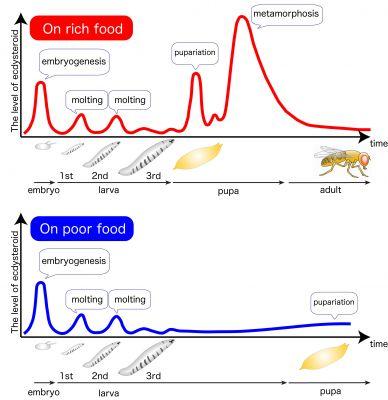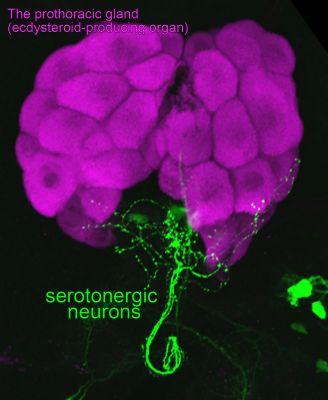Research News
Food for thought

Tsukuba researchers discover an exciting new link between nutrition and development in fruit flies that involves a direct association between the brain and parts of the insect organ secreting the important hormone. It helps to explain when and how caterpillars turn into butterflies and may help us to understand how and when children develop into adults.How is the timing of puberty controlled? The answer may lie in understanding the timing of metamorphosis, the insect version of puberty, according to research recently reported by Dr. Yuko Shimada-Niwa and Dr. Ryusuke Niwa from the University of Tsukuba. This research was published on December 15, 2014 in the highly regarded scientific journal, Nature Communications.
The timing of the developmental change from caterpillar to butterfly, or child to adult, is closely linked to diet. The main hormones involved in this change are steroid hormones. In humans, steroid hormones are responsible for puberty and made in the brain and/or sex organs. Their production is strongly influenced by diet. Without proper nutrition, steroid hormone production is delayed, resulting in a delay in the onset of puberty. On the other hand, the link between the current obesity epidemic in many countries and the early onset of puberty continues to cause a great deal of concern.
Using the insect version of the lab rat, the fruit fly Drosophila melanogaster, the Niwa lab studied the insect form of steroid hormone, ecdysteroid. Ecdysteroid is essential for metamorphosis, the incredible transformation from a larva (the fly version of a caterpillar) to a pupa (the fly version of a cocoon) and finally, to an adult fly.
The use of very elegant genetic techniques and detailed anatomical studies under the microscope allowed the researchers to find a group of neurons that directly project from the brain into the prothoracic gland (PG), the specialized ecdysteroid-producing organ near the brain, as well as beyond ? into the first part of the gut ? the feeding equipment, such as the mouth and foregut. "The neuronal morphology is so complicated that no one could follow the tracts of neurons and the positions of cell bodies to date", said Yuko. She painstakingly dissected many genetically-tagged fly larvae to identify this neuronal pathway that extends outside the brain and into the feeding equipment of the flies.
Surprisingly, the neuronal projections changed depending on what sort of food the larvae were given. When fed a normal yeast-rich diet, the neuronal projection was significantly longer than when the larvae were starved. In the starved larvae, development was also delayed. When the starved larvae were given the normal diet, the effects of the previously poor diet were reversed and development continued as normal.
This group of neurons that extends outside the brain produces the neurotransmitter serotonin. Serotonin, sometimes called the 'happiness hormone' in humans, has roles in both humans and insects in memory, appetite, sleep and behavior. When the function of these serotonin-producing neurons was disrupted in fruit flies, the level of ecdysteroid was reduced and development was delayed. The researchers hypothesized that on a normal diet, serotonin is released by these neurons into the ecdysteroid-producing organ, the PG, stimulating it to make high amounts of ecdysteroid, thus allowing development to proceed. The fact that these neurons are also directly associated with the insect hormone-producing organ suggests an exciting new role for serotonin in linking diet to steroid hormone formation and subsequently, to a role in metamorphosis. According to Ryusuke, "the genetic programs can be flexibly coordinated in the context of the nutrient environment. This mechanism allows animals to increase survival fitness and reproductive success."
So, in fruit flies at least, the happiness hormone serotonin to help control the timing of development in the nutrient-dependent manner. But what about us? We get butterflies in our stomach just thinking about it...

Figure 1: The levels of ecdysteroid during insect development On a normal yeast-rich diet, ecdysteroid is synthesized at the proper time and initiates embryogenesis, molting, pupariation and metamorphosis. On a poor diet, however, the timing of ecdysteroid biosynthesis is delayed in the late 3rd instar stage so that the timing of pupariation is also delayed.

Figure 2. A subset of serotonergic neurons directly innervating the prothoracic gland. In the 3rd instar larva of the fruit fly Drosophila melanogaster, the prothoracic gland (PG, ecdysteroid-producing organ, magenta) and serotonergic neurons (green) were visualized by immunohistochemistry. The PG is a ball-shaped endocrine organ, consisting of about 50 cells. Serotonergic neurons extend from the brain to the PG, secreting serotonin for ecdysteroid biosynthesis.
Original Paper
Yuko Shimada-Niwa & Ryusuke Niwa, Serotonergic neurons respond to nutrients and regulate the timing of steroid hormone biosynthesis in Drosophila, Nature Communications, 5, doi:10.1038/ncomms6778 (2014).


